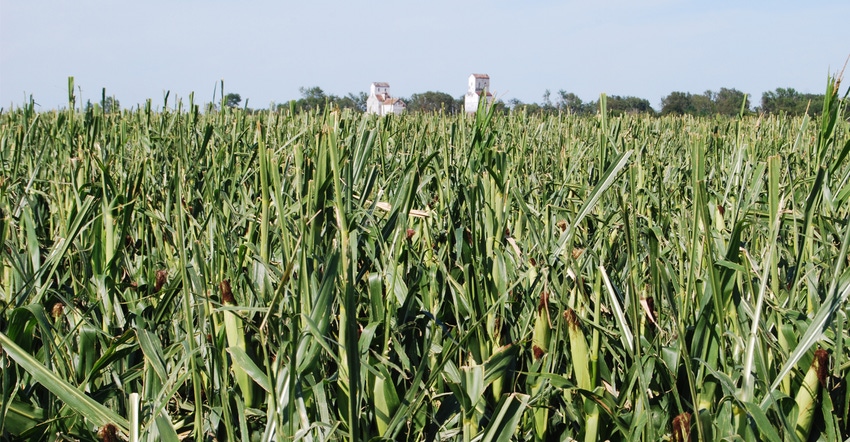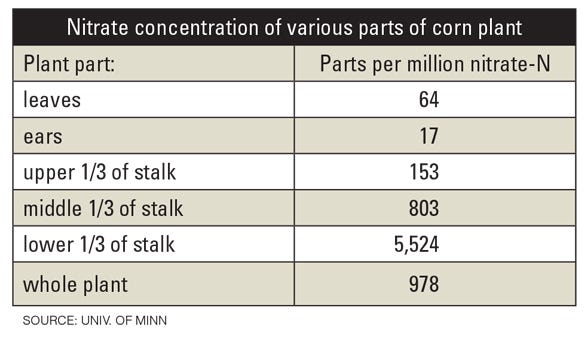August 25, 2020

Drought and windstorm damage to cornfields will result in more corn harvested as silage this year. The decision to chop corn for silage should be made when there is no further potential to increase grain dry matter, and whole plant moisture is in the proper range for the storage structure, advises Brian Lang, an Iowa State University Extension agronomist.
Proper harvest moisture content is the same for drought-stressed corn as normal corn, he says. Recommended whole plant moisture contents are:
65% to 70% in horizontal silos (trenches and bunkers)
60% to 70% for bags
60% to 65% for upright stave silos
50% to 60% for upright oxygen limiting silos
“You need to randomly sample stalks from the field and test for whole-plant moisture of chopped corn to ensure that proper fermentation will occur,” Lang says. “Using a chipper-shredder and forced air dryer is the preferred method of determining moisture. Other methods include using an oven, microwave, electronic forage tester or NIR — a near-infrared spectrometer for measuring moisture content.”
This corn has less feed value
The whole plant yield of severely lodged or broken cornstalks at the milk, dough or initial dent stages of corn plant development are about 65%, 75% and 85%, respectively, compared to fully dented corn harvested at the stage when the milk line has formed halfway up the kernel. The energy value of late milk to dough stage corn is about 80% to 90% of normal corn silage.
The feed value of drought-stressed corn with ears (when yield is 40 bushel per acre or more) has about the same pound-for-pound value as normal corn silage, Lang says. It has increased sugar content, higher crude protein, higher crude fiber and more digestible fiber than normal corn silage. Drought reduces yield and grain content resulting in increased fiber content, but this is often accompanied by lower lignin production, increasing fiber digestibility.
Depending on farm forage needs, raising the cutter-bar on the silage chopper reduces yield but increases quality. For example, raising cutting height reduced yield by 15%, but improved the silage quality so the amount of milk produced by cows per acre of corn silage was only reduced 3% to 4% in University of Wisconsin studies. In addition, the plant parts with highest nitrate concentrations (the lower one-third of the stalk) remain in the field.
Nitrate and mycotoxin concern
With lodged corn, raising the cutter-bar may not be an option. The lower part of the plant is highest in nitrate (see accompanying table). The only way to know the actual composition of drought-stressed corn silage is to have it tested by a commercial feed testing lab to estimate nitrate concentration and nutritive value for livestock. During silage fermentation, the nitrate concentration usually decreases by one-third to one-half, thus you should sample the forage after the ensiling process is complete. Silage with high nitrate levels can be managed by dilution with other feeds.

During the ensiling process, if plants contain nitrates, a brown cloud may develop around your silo. This cloud contains highly toxic gases and people and livestock should stay out of the area.
Some of the drought area in Iowa this summer was hot (greater than 86 degrees F) and dry during pollination, which is favorable for an aspergillus fungus infection. This was followed by temperatures greater than 80 degrees daytime, along with greater than 70 degrees nighttime and drought during grain fill. Those conditions favor aspergillus development.
Aspergillus fungus can produce the aflatoxin mycotoxin as kernel moisture decreases, with the highest production occurring at 18% to 20% kernel moisture. Most corn silage is harvested at 40% to 50% kernel moisture, so there is less chance of problems with aflatoxin, but the silage should be tested before feeding.
Various quality issues and potential toxicity may be of concern this year, including nitrates, aflatoxin and blue-green algae, says Chris Clark, ISU Extension livestock specialist. The Iowa Beef Center has drought resources and information about these and other issues.
Source: ISU, which is solely responsible for the information provided and is wholly owned by the source. Informa Business Media and all its subsidiaries are not responsible for any of the content contained in this information asset.
You May Also Like




